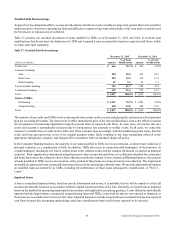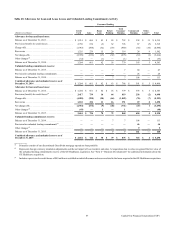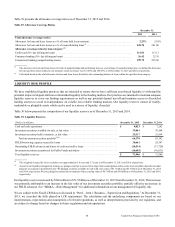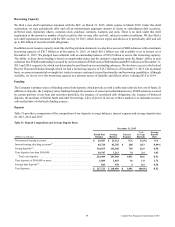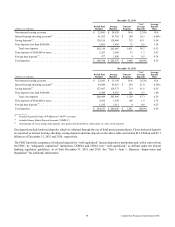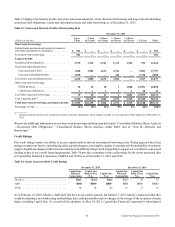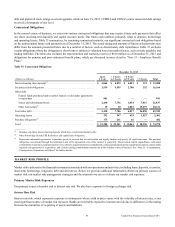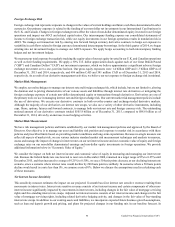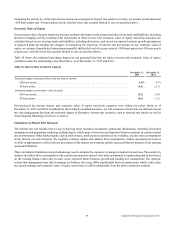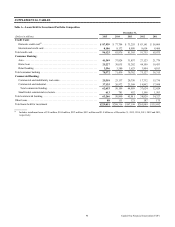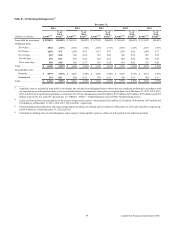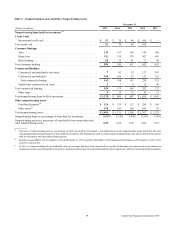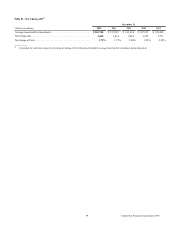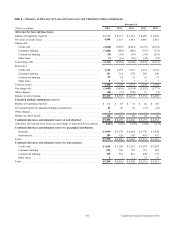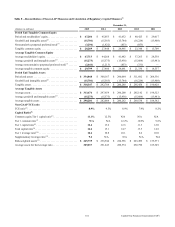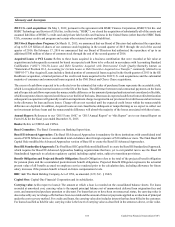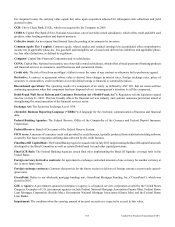Capital One 2015 Annual Report Download - page 114
Download and view the complete annual report
Please find page 114 of the 2015 Capital One annual report below. You can navigate through the pages in the report by either clicking on the pages listed below, or by using the keyword search tool below to find specific information within the annual report.
95 Capital One Financial Corporation (COF)
measuring the sensitivity of interest rate movements on our projected interest rate sensitive revenue, we assume an instantaneous
+200 basis points and -50 basis points shock, with the lower rate scenario limited to zero as described above.
Economic Value of Equity
Our economic value of equity sensitivity measure estimates the impact on the net present value of our assets and liabilities, including
derivative hedging activity, resulting from movements in interest rates. Our economic value of equity sensitivity measures are
calculated based on our existing assets and liabilities, including derivatives, and do not incorporate business growth assumptions
or projected plans for funding mix changes. In measuring the sensitivity of interest rate movements on our economic value of
equity, we assume a hypothetical instantaneous parallel shift in the level of interest rates of +200 basis points and -50 basis points
to spot rates, with the lower rate scenario limited to zero as described above.
Table 36 shows the estimated percentage impact on our projected base-line net interest income and economic value of equity,
calculated under the methodology described above, as of December 31, 2015 and 2014.
Table 36: Interest Rate Sensitivity Analysis
December 31,
2015
December 31,
2014
Estimated impact on projected base-line net interest income
+200 basis points. . . . . . . . . . . . . . . . . . . . . . . . . . . . . . . . . . . . . . . . . . . . . . . . . . . . . . . . . . . . . . . . . . . . . . . 2.6% 4.5%
–50 basis points . . . . . . . . . . . . . . . . . . . . . . . . . . . . . . . . . . . . . . . . . . . . . . . . . . . . . . . . . . . . . . . . . . . . . . . . (1.6) (2.1)
Estimated impact on economic value of equity
+200 basis points. . . . . . . . . . . . . . . . . . . . . . . . . . . . . . . . . . . . . . . . . . . . . . . . . . . . . . . . . . . . . . . . . . . . . . . (5.2) (3.4)
–50 basis points . . . . . . . . . . . . . . . . . . . . . . . . . . . . . . . . . . . . . . . . . . . . . . . . . . . . . . . . . . . . . . . . . . . . . . . . (0.6) (1.2)
Our projected net interest income and economic value of equity sensitivity measures were within our policy limits as of
December 31, 2015 and 2014. In addition to these industry standard measures, we will continue to factor into our internal interest
rate risk management decisions the potential impact of alternative interest rate scenarios, such as stressed rate shocks as well as
steepening and flattening yield curve scenarios.
Limitations of Market Risk Measures
The interest rate risk models that we use in deriving these measures incorporate contractual information, internally-developed
assumptions and proprietary modeling methodologies, which project borrower and depositor behavior patterns in certain interest
rate environments. Other market inputs, such as interest rates, market prices and interest rate volatility, are also critical components
of our interest rate risk measures. We regularly evaluate, update and enhance these assumptions, models and analytical tools as
we believe appropriate to reflect our best assessment of the market environment and the expected behavior patterns of our existing
assets and liabilities.
There are inherent limitations in any methodology used to estimate the exposure to changes in market interest rates. The sensitivity
analysis described above contemplates only certain movements in interest rates and is performed at a particular point in time based
on the existing balance sheet and, in some cases, expected future business growth and funding mix assumptions. The strategic
actions that management may take to manage our balance sheet may differ significantly from our projections, which could cause
our actual earnings and economic value of equity sensitivities to differ substantially from the above sensitivity analysis.


